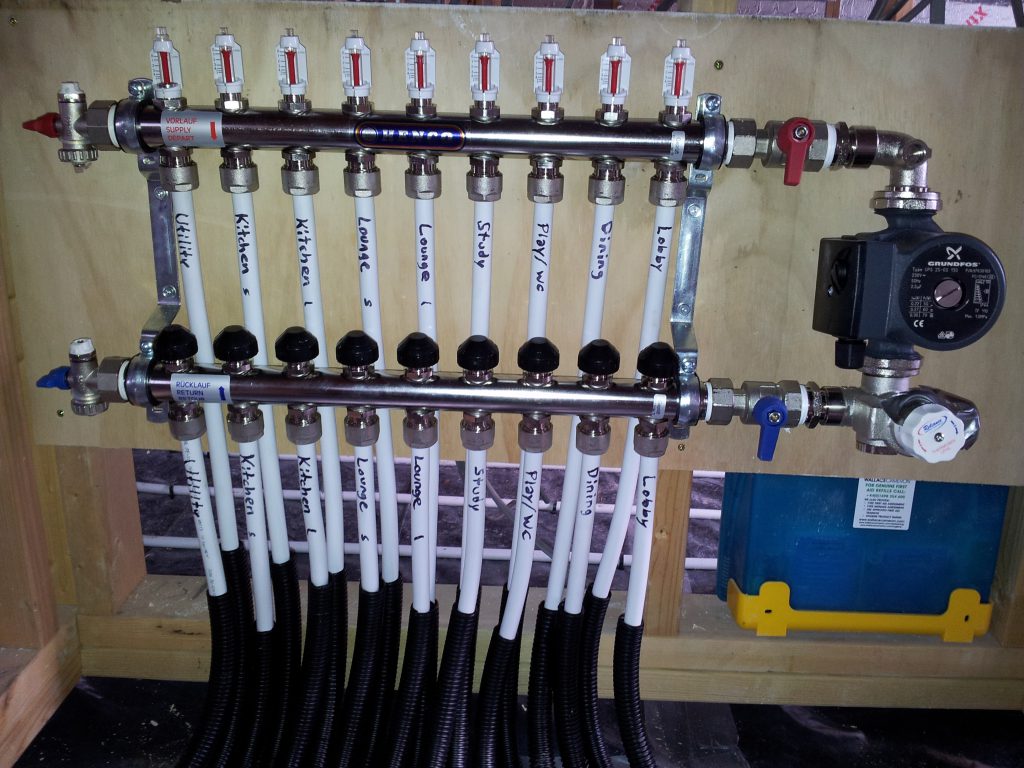Underfloor Heating FAQ Part One
Below we have tried to answer some of the common questions that we get asked here at Underfloor Heating Systems Limited. We get so many questions, and we do try our best to answer them all! We will continue to answer more questions later on, so please keep on checking this blog.
Q. Can wet underfloor heating freeze in the winter?
A: Once the system is up and running within the occupied property, the answer really is no. The room thermostats we use come with a frost setting which means that the room temperature will never be able to drop below zero degrees C.
There is however a sensitive period from the date of filling the system (installation date) and until the system is up and running. The pressurized water within the pipe and manifold must not under any circumstances be allowed to freeze. Not only all walls but also all doors and windows must be fitted to the property before the UFH is installed. It is important to screed over the pipework as soon as possible after the pipe has been installed and filled, as the screed will give added protection. If needed, an air heater should be heating the manifold 24/7 when the outside temperature is below freezing. If there is an added risk of the pipework freezing then anti-freeze could be used or the water in the pipes should be blown out of the UFH system using an air compressor.
Q. I have not followed the above guidelines and can see one pipe has swollen slightly at the manifold due to frost. What should I do?
A. Release the pressure at manifold by opening one of the valves, so that the ice can move instead of breaking the pipe. Once you are sure the ice has thawed, do another pressure test.
Q. Why should underfloor heating be on constantly?
A. Underfloor heating is not a fast response system like radiators. The typical water temperature for an underfloor heating system can be as low as 35-45 degrees C compared to radiators that may run at e.g. 80 degrees C. The underfloor heating system needs to keep the concrete warm, so it is cheaper to run the system 24/7 but at a lower air temperature than the radiator systems run at.
Q. Why does under floor heating stop working?
A. Well it shouldn’t really if a high quality system was installed and installed correctly. There could be a number of reasons for systems to suddenly stop working or perform less well. For example there could be air in the loops, debris in the mixing valve, a faulty pump, a faulty actuator or a faulty room thermostat. An underfloor heating specialist should be called out if the system is not working correctly, unless you can locate the problem yourself.
Q. Who supplies the best underfloor heating systems?
A. Well, here at Underfloor Heating Systems Limited we would of course say we do! The quality of both the Henco pipe and the German Dumser manifold is extremely high. We have used the same pipe and manifold since 2002 – when the company was established – and with no regrets. Not only does the pipe have a 50 year guarantee, but it is also approved for 10 bar pressure 95 degrees C. The electronics are all from UK based manufacturer Heatmiser who are now a market leader within the UK for underfloor heating controls. The pump is an A rated one from Grundfos while the mixer valves come from Reliance Water Controls – all leaders in their field.
Q. Where should an UFH manifold be fitted?
A. The manifold should be fitted centrally to avoid unnecessarily long pipe runs. Long pipe runs mean the feeder pipes will cause interference with e.g. hallway thermostats, not to mention the fact that more pipe will normally be required when the manifolds are not positioned sensibly. Normally the UFH manifold would be fitted under the stairs or in a cupboard, unless the utility room or garage was central enough.

One of our recently installed manifolds. Anders Berg, the installer for this project, marked up each circuit clearly, using e.g. a marker pen. Although this picture shows the pump and mixing valve as right hand side mounted, you can also fit it on the left hand side.
Q. How do you test underfloor heating manifold flow meters?
A. To start with you would adjust the flow rates for each loop during installation. This is done by turning the valves on the lower return manifold, reduce this for shorter loops, while you would keep the longer loops fully open. As a factory default the manifold flow for each loop should be fully open as you receive delivery.
Once the system is up and running, the flow meters on the upper flow manifold will show the actual flow of water through each loop. As with the lower manifold you can also adjust flow rates by turning the meters. They can both also work as an isolator.
Q. How do you flush out air from an underfloor heating system?
A. When installing the system each loop must be flushed out individually to get rid of all the air in the system. You can achieve this by connecting hosepipes to the filling/drain valves at the manifold. Do not attempt to fill the manifold loops from the boiler! See our instructions provided with the materials delivered.
We offer free quotes on underfloor heating systems. If you’d like professional advice on installing the systems, please do get in touch.
Copyright (c) 2013 Underfloor Heating Systems Ltd

